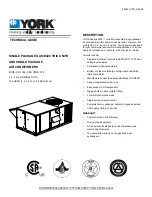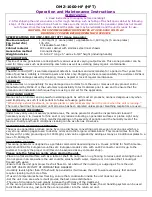
8
DELUXE KIT INSTRUCTIONS
WATERSIDE ECONOMIZER PIPING AND VALVE INSTALLATION:
1) Refer to the accompanying illustrations for recommended piping and valve mounting layout. The piping
layout may be varied from that illustrated, to suit on-site conditions or requirements, provided that the
correct water flow arrangement is maintained. The 3-
way diverting valve ports are marked ‘A’, ‘B’, and ‘C’.
The common port need to be changed from port C to port A if the common port is not port
‘A’ (Please see
the appendix I.
—-3 way waterside economizer diverting valve adjustment)
. Proper orientation of the valve
ports is critical for correct operation of the economizer cycle.
2) All required fittings, and the straight tube lengths, are provided with the kit (see piping assembly A-D
illustrations for full instructions). Wrought coppe
r adapters are provided with the kit to adapt the 3 X 2”NPT
valve connections, and the CS
V Unit’s 2” NPT water inlet connection, to 2-1/8 OD copper tube fittings.
3) It is recommended that the connection of the economizer-bypass pipe branch, to the CSV condenser water
inlet, be soldered or brazed in place in after being fully threaded into the unit inlet fitting. This will ensure that
this joint remains a permanent leak-free connection. (See accompanying photo on page 5)
4) The copper adapters for the 3-way valve should be first soldered to the short lengths of tubing (see piping
assembly “B”) connecting them to the adjacent fittings, before being threaded into the valve body (Do not
install the valve actuator until piping assembly is complete). A low-temperature solder alloy should be used
to prevent annealing or out-of round distortion which can occur with high temperature brazing. Use a good
quality pipe sealant on the threaded fittings, and fully tighten the adapters into the brass valve body (Torque
should not exceed 75 ft-lb).
5) Assemble the tubing and fittings into the correct arrangement as shown. Tack all tubes in place before
soldering to ensure proper fit-up.
6) Pressure test the completed piping assembly with nitrogen. Test pressure should at least equal the working
water supply pressure to the unit (
NOTE:
Maximum pressure rating for the 3-way diverting valve is 580 psig).
7) Locate the remote electronic temperature sensor (it will be attached to the Temperature Control Panel
assembly). The sensor must be securely attached to the surface of the incoming water supply line, upstream
of the 3-way valve (use wire ties, tape, or gear clamps). The two sensor leads must be connected to the
terminal strip on the Temperature Control Panel. A wire routing hole is provided in the condenser corner post
of the unit (early model units require field punching
– use a wire protection bushing).
8) Insulate all exposed water piping to prevent sweating; ensure that the water temperature sensor location is
well insulated. Insulation should cover horizontal stub-outs on economizer coil; insulation of the vertical coil
headers is not required.
9)
Install actuator motor to the 3-way diverting valve. Before tightening the self-centering shaft adapter,
manually rotate the diverting valve stem to the fully counter-clockwise position. The actuator motor position
should be in the fully counter-clockwise position; if not, depress the black
‘de-clutch’ button and rotate the
shaft adapter assembly to the fully CCW position stop. Slide the anti-rotation bracket forward to engage the
clip on the connection end of the actuator motor.
10)
Remove the cover from the actuator, and connect three wire leads to the terminal strip. Lead length must
be sufficient to reach the terminal strip of the ‘Temperature Control Panel’, which will be installed
immediately inside the left hand end panel of the condenser section (behind the water bypass piping / valve
assembly). See Panel wiring diagram for proper terminal connections.
Содержание CVWSEK-240BK/DP
Страница 5: ...5 LEFT HAND COIL BRACKET RIGHT HAND COIL BRACKET DRAIN PAN DRAIN PAN SUPPORT ANGLE ...
Страница 7: ...7 ...
Страница 10: ...10 ASSEMBLY A ASSEMBLY B ...
Страница 11: ...11 ASSEMBLY D ASSEMBLY C ...








































